Goliath's height is a topic of debate, ranging from about 6 feet 9 inches to 9 feet 9 inches. The differences arise from ancient texts, like the Masoretic Text and the Septuagint. One says he was "six cubits and a span," translating to nearly 9 feet 9 inches, while the other suggests "four cubits and a span," or about 6 feet 9 inches. This variation is partly due to different definitions of a cubit. Goliath's towering stature symbolizes the overwhelming challenges one might face, much like those legendary hurdles that inspire stories of triumph and resilience. There's even more to uncover about him and his legacy.
Key Takeaways
- Goliath's height is described as "six cubits and a span," translating to approximately 9 feet 9 inches (2.97 meters) in the Masoretic Text.
- The Septuagint records a shorter height of "four cubits and a span," approximately 6 feet 9 inches (2.06 meters).
- Variability in cubit definitions (18 to 20 inches) affects the interpretation of Goliath's height across different manuscripts.
- The Dead Sea Scrolls support the shorter height, aligning with the Septuagint and raising questions about the Masoretic Text's accuracy.
- Overall, estimates of Goliath's height range from 6 feet 9 inches to 10 feet 6 inches, reflecting ancient measurement complexities.
Introduction

In the story of David and Goliath, Goliath's towering height plays a crucial role in shaping his character as a fearsome warrior. Described in 1 Samuel 17:4 as "six cubits and a span," Goliath's height translates to an impressive 9 feet 9 inches according to the Masoretic Text.
However, different translations offer varying interpretations of his stature. The Septuagint, for instance, states he was "four cubits and a span," which would make him about 6 feet 9 inches tall.
These discrepancies arise from variations in ancient manuscripts, including the Dead Sea Scrolls, leading to estimates of Goliath's height ranging from 6 feet 9 inches to an astonishing 10 feet 6 inches.
Given that the average height of men during biblical times was around five and a half feet, Goliath's stature wasn't just remarkable; it was intimidating. His height significantly contributed to his role as a formidable champion for the Philistine army, instilling fear in those who opposed him.
Understanding Goliath's height helps you appreciate the narrative's dynamics and the monumental challenge David faced in confronting such a giant.
Goliath's Height in Cubits

When you look at Goliath's height in cubits, the primary Bible references give you some striking numbers.
The description in 1 Samuel 17:4 states he stood at "six cubits and a span," while other texts offer a different take.
These variations prompt you to consider how these ancient measurements influence our understanding of Goliath's true height.
Primary Bible References
Goliath's height is a topic of debate due to differing biblical accounts, primarily found in 1 Samuel 17:4. According to the Masoretic Text, Goliath stands "six cubits and a span," which translates to approximately 9 feet 9 inches (2.97 meters). This towering figure has sparked fascination and discussion among scholars and enthusiasts alike.
However, the Septuagint presents a conflicting account, stating Goliath's height as "four cubits and a span," equating to about 6 feet 9 inches (2.06 meters).
These discrepancies arise from different interpretations of ancient measurements, such as the cubit, typically considered to be around 18 inches, and the span, approximately 9 inches. The variations in Goliath's height highlight the complexities of textual transmission over centuries, leading to estimates ranging from 8 feet 5 inches to 10 feet 6 inches based on the manuscript consulted.
Ultimately, these primary Bible references reveal how translations can shape our understanding of historical figures. Whether you lean toward the Masoretic Text or the Septuagint, Goliath's height remains a fascinating exploration of biblical interpretation.
Secondary Bible References
Understanding Goliath's height through secondary Bible references reveals additional layers to this intriguing figure. In 1 Samuel 17:4, Goliath's height is described as "six cubits and a span," which translates to approximately 9 feet 9 inches (2.97 meters) based on the Masoretic Text's interpretation. A cubit is generally about 18 inches, while a span is around 9 inches, leading to varying estimates depending on definitions.
However, the Septuagint, an ancient Greek translation of the Hebrew text, records Goliath's height as "four cubits and a span," equating to roughly 6 feet 9 inches (2.06 meters). This significant difference raises questions about the accuracy of translations.
Variations in the measurement of a cubit can differ based on individuals and contexts, contributing to discrepancies in Goliath's reported height across different translations.
This debate over Goliath's height highlights broader discussions in textual criticism regarding the reliability of ancient manuscripts. When comparing the Masoretic Text with the Septuagint, you see that Goliath's stature becomes not just a matter of physical dimensions, but also a reflection of the complexities in biblical interpretation.
Ancient Philistine Warrior Culture
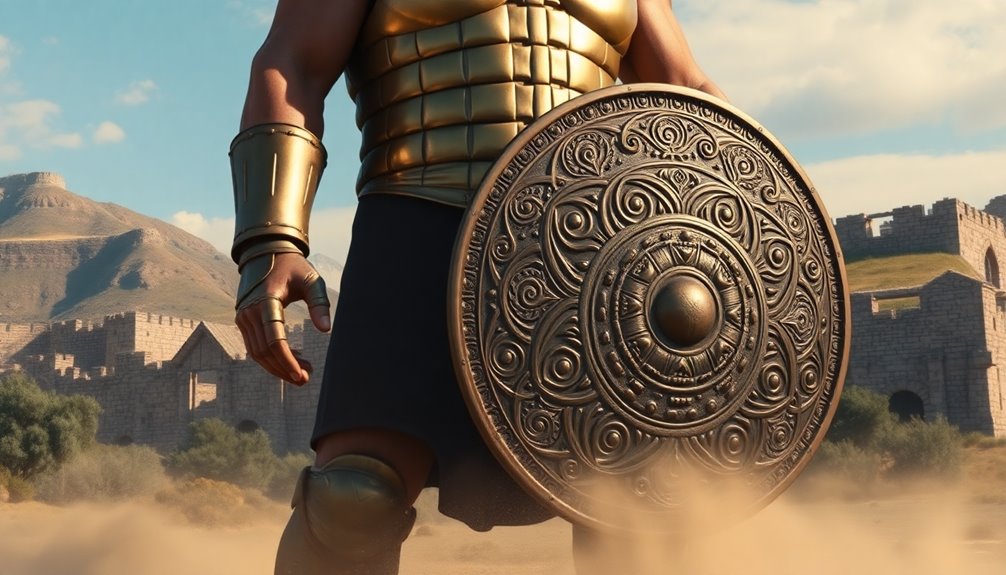
The ancient Philistines were renowned for their warrior culture, which prioritized strength, skill, and advanced military technology. Their Philistine army was a formidable force, often clashing with the Israelites during biblical times. This culture valued champions like Goliath, who symbolized the height of Goliath's physical prowess and combat skills. Goliath, hailing from Gath, represented the epitome of what it meant to be a Philistine warrior, instilling fear in his opponents through his immense size and strength.
Ancient texts highlight the advanced weaponry and armor the Philistines employed, including bronze swords and shields, setting them apart from other forces in the region. Their military tactics often involved employing champions to challenge opposing warriors, a practice that elevated the significance of individual combat in their warrior culture.
The conflicts between the Philistines and Israelites, particularly through figures like Goliath, showcase the historical tensions and territorial disputes of the ancient Near East. In this warrior society, might wasn't just a physical trait but a cultural ideal, reflecting the Philistines' relentless pursuit of dominance on the battlefield. Their legacy as skilled warriors continues to influence perceptions of ancient military history.
Cultural Significance of Height
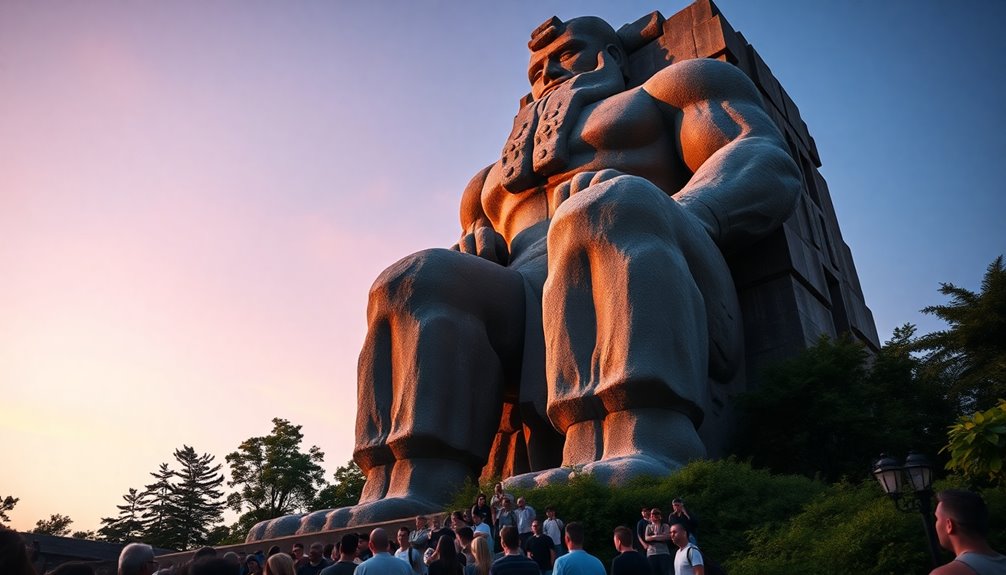
Height in ancient cultures often carried profound significance, especially when it came to figures like Goliath. His height, estimated between 9 feet 6 inches and 10 feet 6 inches, symbolizes the overwhelming challenges individuals and nations face, particularly in the context of faith and adversity. Goliath wasn't just a giant; he represented the moral and spiritual hurdles that heroes like David had to confront.
In biblical narratives, figures like Goliath embody fear and obstacles, which often require divine intervention to overcome. These giants serve as metaphors for struggles against seemingly insurmountable odds, reinforcing themes of courage and faith throughout religious teachings.
The cultural significance of Goliath's height extends beyond the scriptures, influencing literature and art that depict giants as symbols of tyranny and oppression.
When you contemplate Goliath, you're not just thinking about a tall warrior; you're reflecting on the broader human experience of battling giants in your life. The legacy of Goliath continues to inspire narratives about the triumph of the underdog, reminding you that even the most daunting challenges can be met with faith and resilience.
Height Measurement Confusion
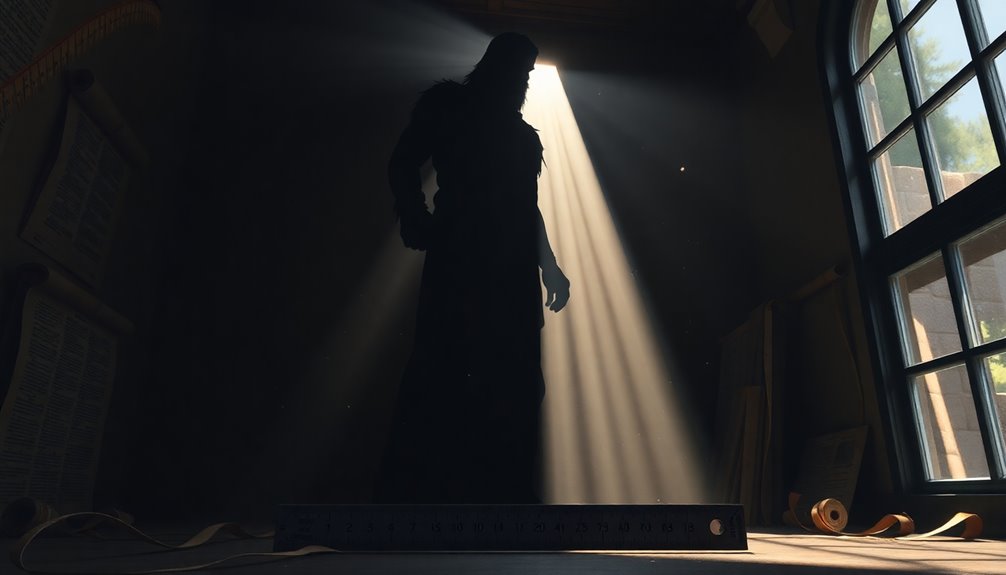
When you think about Goliath's height, it's easy to get confused by the different measurements in biblical texts.
The inconsistency in cubit definitions and variations in translations can lead to misconceptions about how tall he really was.
Let's unpack these discrepancies and see how they affect our understanding of this iconic figure.
Debunk Common Misconceptions
Many people mistakenly believe Goliath's height is definitively 9 feet 9 inches, but this figure stems from the Masoretic Text, which isn't the only source. In fact, Goliath's height is described as six cubits and a span, leading to different interpretations across English translations.
The Septuagint and some Dead Sea Scrolls present a contrasting measurement of four cubits and a span, translating to about 6 feet 9 inches. This significant difference highlights the textual discrepancies that exist regarding Goliath's height.
Variations arise partly due to the differing definitions of a cubit, which can range from 18 to 20 inches. This flexibility can lead to a height discrepancy of several feet, complicating the discussion surrounding Goliath.
It's essential to recognize that these discrepancies may stem from scribal errors or intentional alterations over time.
Despite the debates about Goliath's height, remember that the core of the narrative remains intact. The story emphasizes the contrast between faith and physical might, transcending the specifics of numerical measurements.
Understanding these misconceptions helps clarify the tale's true message.
Height Measurement Variability
The confusion surrounding Goliath's height stems from variations in how measurements were recorded and interpreted in ancient texts. In the Masoretic Text, Goliath stands at six cubits and a span, which translates to about nine feet nine inches. However, the Septuagint offers a shorter measurement of four cubits and a span, roughly six feet nine inches. This height measurement variability arises partly from differing definitions of a cubit, which can range from 18 to 20 inches, significantly impacting final calculations.
Moreover, the discovery of the Dead Sea Scrolls supports the shorter height, aligning with the Septuagint's readings and highlighting inconsistencies in textual transmission. Textual criticism plays a crucial role here, as it reveals that scribal errors or even intentional alterations could explain the discrepancies found across various ancient manuscripts.
Ultimately, the debate over Goliath's height reflects broader questions about the accuracy of biblical narratives and how we interpret scripture in historical contexts. By examining these factors, you can better understand why there's so much discussion surrounding Goliath's towering stature.
Height in Leadership Context

When you think about leadership, consider the personal giants you might face, just like David confronted Goliath.
It's not just about physical presence; your faith and courage play a crucial role in overcoming challenges. Understanding small mistakes can also be pivotal in developing effective leadership skills.
Overcoming Personal Giants
Overcoming personal giants in leadership often feels like facing a modern-day Goliath. Just like David, you might encounter formidable challenges that seem overwhelming, such as self-doubt, fear, and external pressures.
These giants can loom large, casting shadows over your confidence and decision-making. To succeed, you'll need to draw on your own faith and courage.
Remember, true leadership isn't about towering height or power; it's about inspiring others and leading with conviction. Embrace the idea that your unique strengths can help you combat these giants effectively.
Strategic thinking is essential when tackling these challenges. Just as David chose a sling and stones over traditional armor, you must identify innovative approaches that play to your strengths.
This resourcefulness can turn your perceived weaknesses into advantages. As you navigate the complexities of leadership, recognize that overcoming personal giants is a journey.
Each step you take builds resilience and fortifies your ability to lead. By confronting these giants head-on, you not only grow personally but also set an example for others, proving that even the tallest obstacles can be conquered. Additionally, just as in co-parenting, establishing clear rules for children can provide the structure needed to face challenges effectively.
Faith in Facing Challenges
Facing challenges in leadership often requires more than just strategic thinking; it demands a deep-rooted faith that can guide you through turbulent times. Just as David faced Goliath, whose towering height symbolized the seemingly insurmountable obstacles you might encounter, your ability to confront such challenges often hinges on your inner conviction.
Goliath's physical might represents the external adversities that can intimidate leaders, yet it's your faith that empowers you to take action.
When facing daunting trials, remember that true leadership is about navigating giants—both those outside and within. David didn't rely on armor or weapons; he drew strength from his faith in God, showcasing the importance of spiritual resilience. Your unwavering belief can help you tackle formidable obstacles that may seem overwhelming, igniting the courage required to persevere.
In moments of doubt, look to David's example. Embrace your faith as a guiding force, reminding yourself that challenges aren't just threats but also opportunities for growth. With conviction in your heart, you can face your own Goliaths, transforming fear into determination and uncertainty into strength. Just as the Psalms selected for their themes of joy and faith uplift believers, so too can your faith uplift you in times of trouble.
Height's Impact on Warfare
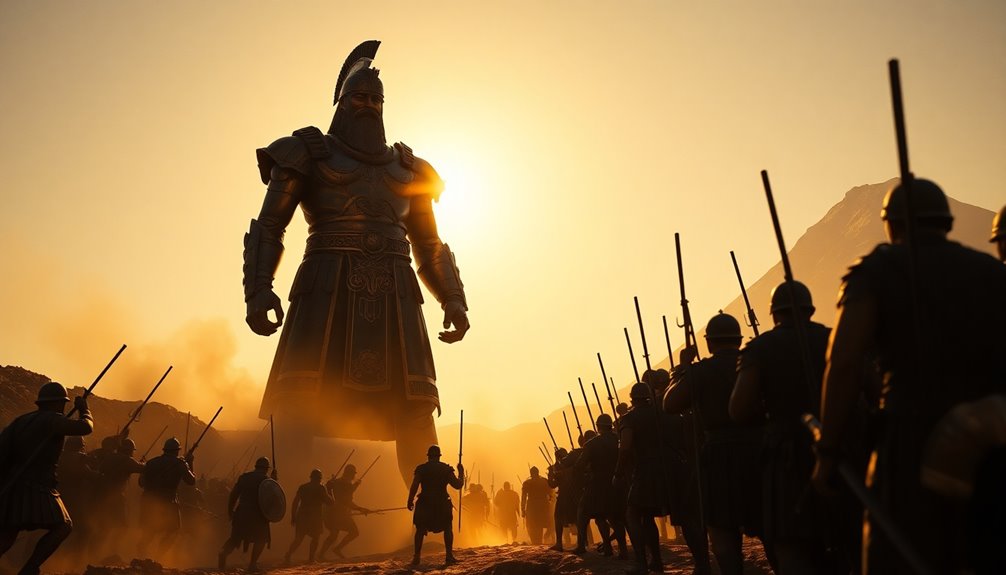
Height has always played a crucial role in warfare, influencing both tactics and morale on the battlefield. Goliath's towering height, estimated between 9 feet 6 inches and 10 feet 6 inches, provided a significant psychological advantage over his enemies. Just his presence instilled fear in opposing soldiers, showcasing the military might of the Philistines. His bronze armor, weighing over 125 pounds, further amplified this intimidating image of a giant warrior ready for battle.
In ancient warfare, the practice of single combat was common, allowing one champion to determine the outcome without engaging entire armies. Goliath's challenge to the Israelites exemplified this tactic, as he represented the strength of his army. The sight of such a formidable opponent could demoralize even the bravest of warriors.
However, the contrast between Goliath's immense size and David's smaller stature highlights a deeper theme: faith triumphing over brute strength. This narrative impacted the morale and strategies of both armies, demonstrating that victory isn't solely reliant on physical attributes.
Instead, the belief in one's capabilities can shift the tide of battle, transcending mere height and strength on the field.
Additional Resources
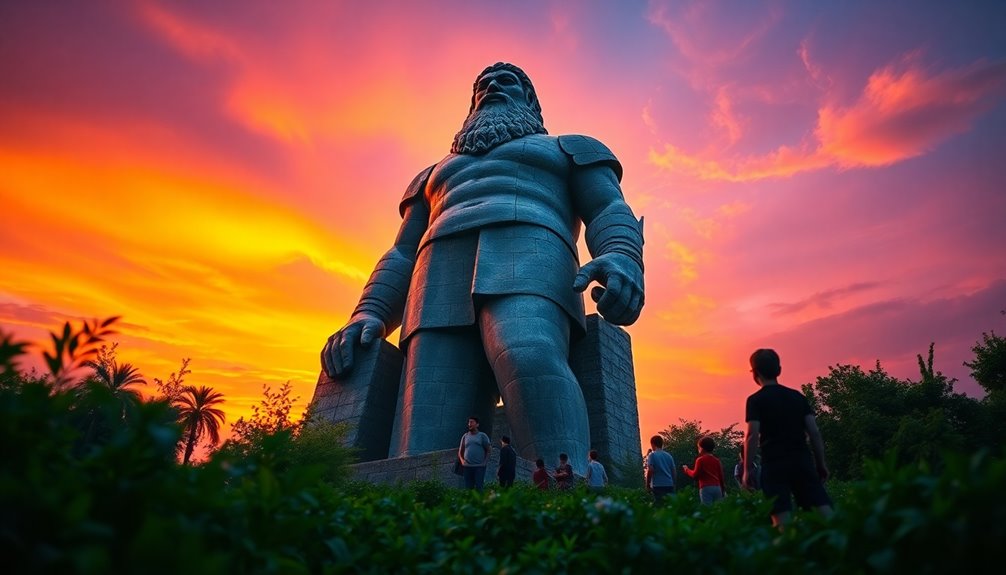
Understanding Goliath's height opens the door to a wealth of resources that explore his significance in biblical history and ancient warfare. For starters, you can dive into various Bible translations, which often depict Goliath's height as six cubits and a span, roughly 9 feet 9 inches.
However, some ancient manuscripts, like the Septuagint and select Dead Sea Scrolls, suggest an alternative measurement of four cubits and a span, translating to about 6 feet 9 inches. These discrepancies highlight the importance of textual criticism, as examining these manuscript differences is crucial for accurate interpretation.
Resources such as "The Greek New Testament" from Tyndale House offer valuable insights into these variations. Additionally, historical context plays a key role in understanding how Goliath fits into the narrative of ancient warfare.
Moreover, archaeological findings indicate that individuals over 7 feet tall existed in ancient times, lending credibility to the notion of Goliath as a giant. Scholars like John D. Meade and Peter J. Gurry have produced works that further illuminate the complexities surrounding Goliath's height, making them excellent resources for your exploration.
Frequently Asked Questions
Who Was the Tallest Person in the Bible?
When you think about the tallest person in the Bible, you might consider Goliath, often described as a giant.
However, don't overlook Og, the king of Bashan. His bed's measurements suggest he could've stood around 13.5 feet tall, making him potentially even taller than Goliath.
While Goliath gets a lot of attention in the David and Goliath story, Og's size adds another layer to the discussion about biblical giants.
What Did Goliath Look Like in the Bible?
Goliath's appearance in the Bible is striking and intimidating.
You'd see him clad in heavy bronze armor, weighing around 125 pounds, which adds to his formidable presence. His giant spear, with a 15-pound head, complements his warrior image.
Described as a Philistine champion, he towers over others, making him a fearsome figure on the battlefield. His sheer size and strength challenge the Israelites, contrasting sharply with David's youth and smaller stature.
How Tall Are Adam and Eve?
You'll find that the Bible doesn't specify Adam and Eve's heights, leaving it open to interpretation.
Some suggest they might've been idealized beings, possibly taller than today's average humans. Various ancient texts speculate Adam's height could range from 15 to 20 feet.
However, since human height has changed over time, it's tough to directly compare their potential stature with modern standards.
Ultimately, their physical appearance remains largely a matter of belief and imagination.
Is Goliath the Tallest Man That Ever Lived?
You might wonder if Goliath's height makes him the tallest man that ever lived.
While some estimates suggest he stood between 6 feet 9 inches and 9 feet 9 inches, historical records indicate that Robert Wadlow, who reached 8 feet 11.1 inches, holds the title for the tallest recorded human.
Goliath's height is often debated and interpreted differently, so he isn't universally recognized as the tallest man in history.










